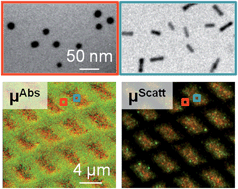Quantitative readout of optically encoded gold nanorods using an ordinary dark-field microscope†
Abstract
In this paper we report on a new use for

Maintenance work is planned for Wednesday 1st May 2024 from 9:00am to 11:00am (BST).
During this time, the performance of our website may be affected - searches may run slowly and some pages may be temporarily unavailable. If this happens, please try refreshing your web browser or try waiting two to three minutes before trying again.
We apologise for any inconvenience this might cause and thank you for your patience.
* Corresponding authors
a
INO-CNR, National Institute of Optics-CNR, Largo E. Fermi 6, Florence, Italy
Fax: +39 055 23081
Tel: +39 055 2337755
b
IFAC-CNR, Institute of Applied Physics-CNR, Via Madonna del Piano 10, Sesto Fiorentino, Firenze, Italy
E-mail:
f.ratto@ifac.cnr.it
Fax: +39 055 5226477
Tel: +39 055 5225304
c
Department of Experimental and Clinical Biomedical Sciences, University of Florence, Viale Pieraccini 6, Florence, Italy
Fax: +39 055 4271413
Tel: +39 055 4271217
In this paper we report on a new use for

 Please wait while we load your content...
Something went wrong. Try again?
Please wait while we load your content...
Something went wrong. Try again?
R. Mercatelli, F. Ratto, S. Centi, S. Soria, G. Romano, P. Matteini, F. Quercioli, R. Pini and F. Fusi, Nanoscale, 2013, 5, 9645 DOI: 10.1039/C3NR00726J
To request permission to reproduce material from this article, please go to the Copyright Clearance Center request page.
If you are an author contributing to an RSC publication, you do not need to request permission provided correct acknowledgement is given.
If you are the author of this article, you do not need to request permission to reproduce figures and diagrams provided correct acknowledgement is given. If you want to reproduce the whole article in a third-party publication (excluding your thesis/dissertation for which permission is not required) please go to the Copyright Clearance Center request page.
Read more about how to correctly acknowledge RSC content.
 Fetching data from CrossRef.
Fetching data from CrossRef.
This may take some time to load.
Loading related content
